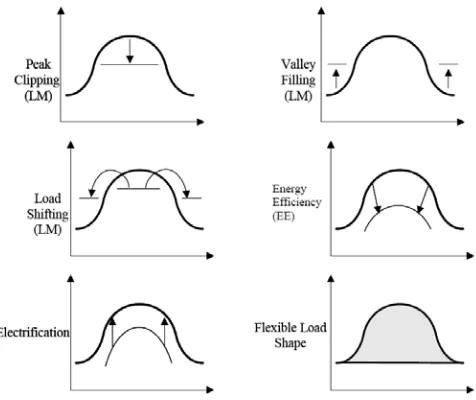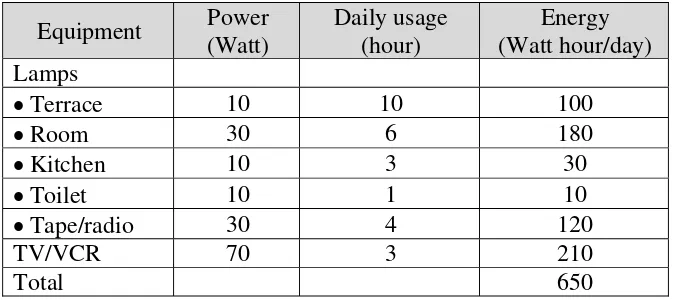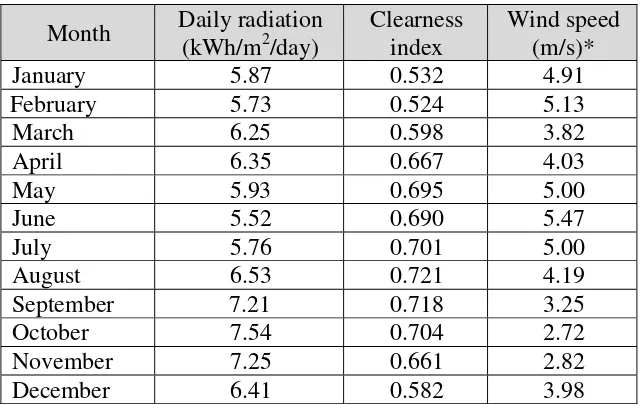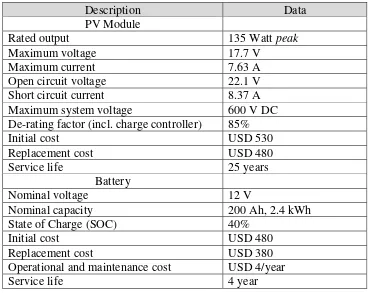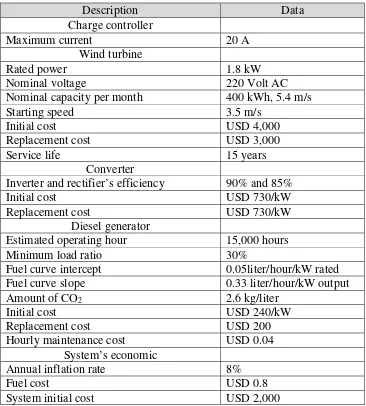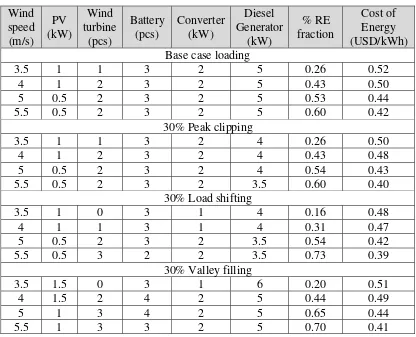LOAD MANAGEMENT EFFECT ON OPTIMUM SIZING OF
STAND-ALONE HYBRID DISTRIBUTED GENERATION
Yusak Tanoto
Electrical Engineering Department, Faculty of Industrial Enginnering Petra Christian University Surabaya
ABSTRACT
This paper presents an optimum sizing assessment for stand-alone hybrid distributed energy system feeding a sub-village sized household community in the rural areas, affected by loading types based on demand side management principle. Simulations are carried out over the combination of hybrid power generation taking into account PV-battery, wind turbine, and diesel generator. Three loading management in which considered in this study are peak clipping, load shifting, and valley filling. Optimum hybrid generation sizing for each loading type is subject to minimum cost of energy. Besides, renewable generation fraction provided system optimum sizing is analyzed accordingly.
The simulation result reveals that the least cost of energy is achieved by load shifting scheme with USD 0.39/kWh taking into account the combination of PV-battery, wind turbine, and diesel generator. In addition, the largest renewable energy fraction obtained from load shifting type as well, accounted for 73%.
Keywords: Load Management, Optimum Sizing, Distributed Generation
ABSTRAK
Makalah ini menyajikan penentuan rating optimal dari pembangkitan listrik tersebar yang menyuplai sebuah komunitas rumah tinggal di pedesaan, yang dipengaruhi oleh variasi tipe pembebanan berdasarkan prinsip manajemen sisi permintaan. Simulasi dijalankan terhadap kombinasi jenis pembangkit listrik hibrid yang terdiri dari PV-baterai, turbin angin, dan genset. Jenis pengaturan pembebanan berdasarkan prinsip manajemen sisi permintaan yang dianalisa pada studi ini adalah peak clipping, load shifting, dan valley filling. Rating pembangkitan optimal hibrid untuk setiap jenis pembebanan ditentukan berdasarkan fungsi objektif biaya energi minimal. Selain itu, fraksi energy terbarukan yang diperoleh pada rating pembangkitan optimal untuk tiap jenis pembebanan juga dianalisa.
Dari hasi simulasi, biaya energi terendah dicapai oleh jenis pebebanan load shifting dengan USD 0.39/kWh yang terdiri dari kombinasi PV-baterai, turbin angin, dan genset. Di samping itu, fraksi energy terbarukan yang terbesar diperoleh dari jenis pembebanan load shifting pula, sebesar 73%.
1. INTRODUCTION
Utilization of stand-alone renewable distributed energy resources in many ways is seen as a promising method in provisioning electricity connection for people living in remote areas (Haidar et.al, 2010). Issues related with the system reliability under renewable energy resources in most cases can be negligible since either energy storage or hybrid system involving conventional non-renewable technologies can be added up as complement to the initial system. Although development of hybrid distributed generation plants are currently technically and economically viable, the cost of energy of a distributed generation system is generally higher than that obtained by bulk generation system. Several optimization methods have been successfully applied to optimize the component sizing and in the same time reduce the associated cost of the hybrid distributed system (Hongxing et.al, 2009). However, the sizing optimization is normally performed for the base case loading condition and therefore it may be changed for any other loading conditions. In addition to system size changing, the associated cost of energy and the environmental impact may be changed as well.
Loading variation shall be directed so that electricity energy can be generated and consumed in an efficient way. In order to achieve this condition, loading pattern can be preconditioned following demand side management loading principle under which load is managed so that the loading pattern can be beneficial to the technical as well as economical point of view.
2. LITERATURE REVIEW
The concept of Demand Side Management (DSM) was first introduced by Gellings and Chamberlin in 1987. DSM includes systematic activities carried out by electricity companies and government designed to change the amount and / or time of use electricity on the customer side including the use of energy efficient appliances (Gellings and Chamberlin, 1987). DSM has two main objectives that are interrelated. First, to reduce peak load requirements so that additional generating capacity can be avoided. The second objective is to reduce electricity use to solve the energy problem by changing the number and pattern of electrical energy consumption (Surapong, 2000). Six goals of DSM activities related to the electrical loading are shown in Fig. 1.
As in Fig.1, peak clipping, valley filling, and load shifting are classified as load management purposes. Energy efficiency includes reduction of all energy use and is also known as energy conservation. Technically, they are different because the level of energy services is maintained by means of energy efficiency but decreased in energy conservation. Electrification includes the construction of the load over all hours and is often associated with a customer retention program from the perspective of energy providers Meanwhile, the flexible load shape is intended to make the load curve is responsive to the reliability of load conditions (CRA, 2005).
3. RESEARCH METHODOLOGY
The system sizing as well as economic viability condition due to limitation of optimization scope is considered shall be enhanced by involving other approach such as load management under DSM so that the result can be further improved. The interesting findings that may be obtained from this research are what type of loading that can generate the most optimal system sizing in terms of technical and economic point of view. In addition, what type of loading that the CO2 reduction as well as the penetration rate of renewable energy resources can be maximally achieved.
3.1. Data collection and System Modeling
The assessment is conducted through simulation involving system’s technical and economic data. Optimization assessment on electricity supply is carried out using HOMER (Hybrid Optimization Model for Electric Renewable) software developed by the US National Renewable Energy Laboratory (Lambert et al, 2006). In addition, the weather condition such as average irradiation and wind speed is needed as the feed into the system energy resources. The system is then after modeled following several references necessarily to run the simulation. The necessary data gathered for overall assessment carried out in this research is comprised of:
3.1.1. Load profile
A hypothetical load profile for a sub-village used in this simulation is based on 50 households (Tanoto, 2011). Typical installed equipment and daily energy requirement for each household is shown in Table 1.
Table 1. Typical electric equipment installed in the rural household
Equipment Power
loading profile with respect to 30% load profile variation is given in Fig.2 and Fig.3, respectively.
Figure 2. Typical daily load profile for: (a) base case, (b) and 30% peak clipping
Figure 3. Daily load profile for: (a) 30% load shifting, and (b) 30% valley filling
3.1.2. Renewable energy data
The observation site is Baa region in Rote Ndao district of East Nusa Tenggara. The site is geographically located on 10°50’ South latitude and 123°0’ East longitude. The weather data as shown in table 2 are gathering from NASA since there is no measurement available from the nearby meteorology station.
Table 2. Weather condition in Baa, Rote Ndao district
Month Daily radiation (kWh/m2/day)
Clearness index
Wind speed (m/s)*
January 5.87 0.532 4.91
February 5.73 0.524 5.13
March 6.25 0.598 3.82
April 6.35 0.667 4.03
May 5.93 0.695 5.00
June 5.52 0.690 5.47
July 5.76 0.701 5.00
August 6.53 0.721 4.19
September 7.21 0.718 3.25
October 7.54 0.704 2.72
November 7.25 0.661 2.82 December 6.41 0.582 3.98
3.1.3. System modeling and configuration
The hybrid power generation system is connected to the household having a total base case energy requirement of 32.5 kWh/day with 6 kW peak load demand. Considering 5% standard deviation in the sequence of daily averages gives the peak load to be 6.5 kW. The base case loading is then changed following to the loading variation scheme as mentioned earlier. A complete configuration containing full technology option considered for hybrid system is shown in Fig. 4.
Figure 4. System configuration in complete option
The hybrid system major equipment is presented in Table 3. The sizing along with the technical and economic data is used as reference for simulation purpose.
Tabel 3. System technical and economic specification data (Tanoto, 2011)
Description Data PV Module
Rated output 135 Watt peak Maximum voltage 17.7 V
Maximum current 7.63 A Open circuit voltage 22.1 V Short circuit current 8.37 A Maximum system voltage 600 V DC De-rating factor (incl. charge controller) 85% Initial cost USD 530 Replacement cost USD 480 Service life 25 years
Battery Nominal voltage 12 V
Nominal capacity 200 Ah, 2.4 kWh State of Charge (SOC) 40%
Table 3. System technical and economic specification data (Continue) Nominal voltage 220 Volt AC Nominal capacity per month 400 kWh, 5.4 m/s Starting speed 3.5 m/s
Initial cost USD 4,000 Replacement cost USD 3,000 Service life 15 years
Converter Inverter and rectifier’s efficiency 90% and 85% Initial cost USD 730/kW Replacement cost USD 730/kW
Diesel generator
Estimated operating hour 15,000 hours Minimum load ratio 30%
Fuel curve intercept 0.05liter/hour/kW rated Fuel curve slope 0.33 liter/hour/kW output Amount of CO2 2.6 kg/liter
Initial cost USD 240/kW Replacement cost USD 200 Hourly maintenance cost USD 0.04
System’s economic
Annual inflation rate 8%
Fuel cost USD 0.8
System initial cost USD 2,000
4. SIMULATION RESULT AND DISCUSSION
HOMER simulates system operational based on the energy balance principle. It counts every hour for 8,760 hours a year. Electric demand in the hour is compared to the energy that the system can supply in that hour and the flow of energy to and from each component of the system is calculated to determine whether it can meet the electric demand under the specified conditions, and estimates the cost of installing and operating the system over the lifetime of the project. The final objective of the simulation is to identify a configuration among a set of systems that meets the desired system reliability requirements with the lowest energy cost. To capture system loading changing, each loading type is simulated separately based on the desired load profile.
Table 4. Optimum sizing and cost of energy for different loading condition
From Table 4, it can be inferred that the benefit of peak clipping in terms of renewable energy fraction and cost of energy is not significant compared to that achieved by base case loading, except for the result obtained by load shifting, which is USD 0.39/kWh. In addition, the highest renewable energy fraction is achieved by load shifting as well with 73% for the fastest wind speed. Moreover, load management peak clipping method may not give the desired improvement on renewable energy fraction as well as reduction on cost of energy due to insignificant changing in hybrid system’s sizing, except a slightly reduction in generator fuel cost.
5. CONCLUSION
In this research, the effect of load management under DSM principle over stand-alone hybrid distributed generation feeding a community in the rural area. The main finding includes the benefit of load shifting over other loading patterns. The grid connected-hybrid system shall be observed in the future study to provide relevant comparison to the current findings.
REFERENCES
Haidar, A.M.A., et.al. Optimal Configuration Assessment of Renewable Energy in Malaysia. Renewable Energy, vol. 36: 881-888, 2010.
Gellings, C.W. dan Chamberlin, J.G. Demand-Side Management: Concepts and Methods. Fairmont Press Inc, 1987.
Surapong, C. Lecture Notes of Demand Side Management”, Asian Institute of Technology, Bangkok, Thailand, 2000.
Charles River Associates (CRA). Primer on Demand Side Management with emphasis on price-responsive programs. Oakland, California, 2005.
Lambert T., et.al. Micropower system modeling with HOMER, integration of alternative source of energy. Available at:
http://www.pspb.org/e21/media/HOMERModelingInformation.pdf. Downloaded on 24 Aug 2009.
Tanoto, Yusak. Optimization Assessment of Off-Grid Hybrid Distributed Generation System for Remote Sub-Village-Sized. Proceeding SITIA ITS Surabaya, 2011.
